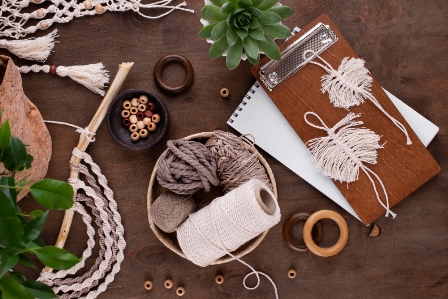In a world increasingly concerned about environmental sustainability, upcycling has emerged as a magical solution to both reduce waste and unleash creativity. But what exactly is upcycling, and why has it gained such popularity in recent years?
What is upcycling?
Upcycling is the process of transforming discarded or useless materials into something of higher quality or value than the original. Unlike recycling, which breaks down materials into raw form, upcycling focuses on repurposing items creatively.
Growing popularity of upcycling
With a heightened awareness of environmental issues and a desire for unique, personalized creations, upcycling has captured the imagination of DIY enthusiasts around the globe.
Benefits of Upcycling
Environmental impact
Upcycling significantly reduces the amount of waste that ends up in landfills, contributing to a healthier planet. By giving old items new life, we decrease the demand for new resources.
Cost-effectiveness
Not only is upcycling eco-friendly, but it’s also budget-friendly. Why invest in expensive decor when you can craft something extraordinary from items you already have?
Personalized creations
Upcycling allows individuals to express their creativity and style, resulting in one-of-a-kind pieces that tell a personal story.
Choosing the Right Materials
Assessing recyclable items
Not everything is suitable for upcycling. Understanding which materials can be repurposed effectively is crucial to the success of your projects.
Creativity meets sustainability
The beauty of upcycling lies in the fusion of creativity and sustainability. Learn to look at everyday objects with a fresh perspective.
DIY Upcycling Projects
Upcycled furniture
Give old furniture a new lease on life with a coat of paint, some imagination, and a touch of DIY magic.
Decorative items from everyday objects
Transform mundane items like glass bottles, tin cans, and old books into eye-catching decor pieces.
Tools and Materials Needed
Basic toolkit
Equip yourself with the essential tools for upcycling success, including sandpaper, paintbrushes, and safety gear.
Safety considerations
Before diving into your upcycling projects, ensure you prioritize safety. Use protective equipment and work in well-ventilated areas.
Step-by-Step Guide: Upcycled Furniture
Preparing the furniture
Begin by cleaning and inspecting the furniture for any repairs or modifications needed.
Sanding and priming
Create a smooth surface for painting by sanding the furniture, followed by applying a primer.
Choosing the right paint
Selecting the right paint is crucial. Consider the type of material and desired finish for optimal results.
Adding personal touches
Make your furniture unique by incorporating personal touches. Stencils, decoupage, or creative distressing techniques can add character.
Step-by-Step Guide: Decorative Items
Transforming glass bottles into vases
Turn empty glass bottles into stunning vases with a splash of paint and a touch of creativity.
Tin can lanterns
Create ambient lighting with tin can lanterns. Simple cuts and strategic candle placement can turn ordinary cans into extraordinary decor.
Old book pages wall art
Repurpose old book pages into captivating wall art. Combine pages creatively for a unique and literary touch.
Showcasing Your Upcycled Creations
Social media platforms
Share your upcycled wonders on social media platforms to inspire others and connect with like-minded individuals.
Local exhibitions and markets
Participate in local events to showcase your creations and contribute to the growing upcycling community.
Upcycling Challenges and Solutions
Dealing with stubborn materials
Some materials may present challenges. Explore innovative solutions or seek advice from the upcycling community.
Finding inspiration
If you ever feel stuck, look for inspiration in nature, art, or even other upcycling projects. Creativity often sparks from unexpected places.
Upcycling for a Cause
Donating upcycled items
Extend the impact of your upcycling efforts by donating items to charities or community organizations.
Community upcycling projects
Collaborate with your community on larger upcycling initiatives to make a collective difference.
Upcycling Tips for Beginners
Start with small projects
If you’re new to upcycling, begin with small, manageable projects to build confidence and skills.
Patience and experimentation
Upcycling is a learning process. Be patient, embrace mistakes, and don’t be afraid to experiment with new ideas.
Future of Upcycling
Sustainable living trends
As sustainability becomes more integral to daily life, the future of upcycling looks promising as a mainstream lifestyle choice.
Innovations in upcycling
Keep an eye on emerging technologies and techniques that may further revolutionize the world of upcycling.
FAQs
While many items can be upcycled, some materials may be challenging. Experimentation and creativity are key.
Always wear protective gear, work in well-ventilated areas, and follow safety guidelines for tools and materials.
Check community boards, local markets, or online platforms for information on upcycling workshops and exhibitions.
Yes, many individuals turn their upcycling hobby into a small business. Local markets and online platforms offer great opportunities.
Begin with small projects, gather basic tools, and don’t hesitate to learn from online tutorials and fellow upcyclers.
Conclusion
In the enchanting realm of upcycling, where creativity meets sustainability, every discarded item has the potential for a magical transformation. As we embrace this DIY movement, we not only contribute to a greener planet but also infuse our lives with unique, handcrafted beauty.


